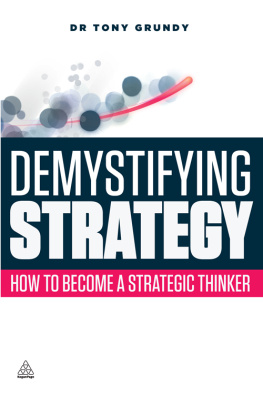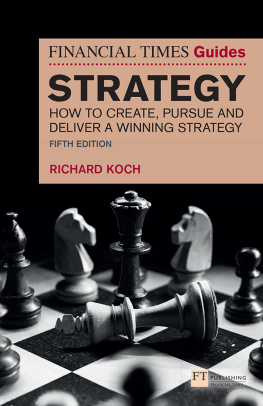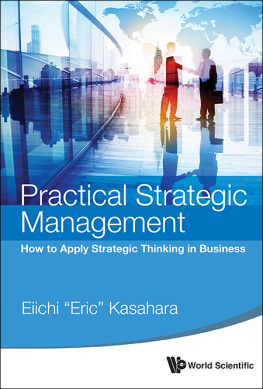The Strategy Bridge:
Theory for Practice
Colin S. Gray
(p.iv) 
- Great Clarendon Street, Oxford OX2 6DP
- Oxford University Press is a department of the University of Oxford.
- It furthers the University's objective of excellence in research, scholarship,
- and education by publishing worldwide in
- AucklandCape TownDar es SalaamHong KongKarachi
- Kuala LumpurMadridMelbourneMexico CityNairobi
- New DelhiShanghaiTaipeiToronto
- ArgentinaAustriaBrazilChileCzech RepublicFranceGreece
- GuatemalaHungaryItalyJapanPolandPortugalSingapore
- South KoreaSwitzerlandThailandTurkeyUkraineVietnam
- Oxford is a registered trade mark of Oxford University Press
- in the UK and in certain other countries
- Published in the United States
- by Oxford University Press Inc., New York
- Colin S. Gray 2010
- The moral rights of the author have been asserted
- Database right Oxford University Press (maker)
- All rights reserved. No part of this publication may be reproduced,
- stored in a retrieval system, or transmitted, in any form or by any means,
- without the prior permission in writing of Oxford University Press,
- or as expressly permitted by law, or under terms agreed with the appropriate
- reprographics rights organization. Enquiries concerning reproduction
- outside the scope of the above should be sent to the Rights Department,
- Oxford University Press, at the address above
- You must not circulate this book in any other binding or cover
- and you must impose the same condition on any acquirer
- British Library Cataloguing in Publication Data
- Library of Congress Cataloging in Publication Data
- Typeset by SPI Publisher Services, Pondicherry, India
- Printed in Great Britain
- on acidfree paper byMPG Books Group
- ISBN 9780199579662
- 13579108642
Dedication
(p.v) To the love of my life, Valerie. (p.vi)
(p.vii) Foreword
You hold in your hands the first original and serious work on strategy of the 21st centuryperhaps the first such book in decades. Written by someone who has thought widely about this topic, read deeply in its history, and contributed to its practice, it belongs on the bookshelf of students and practitioners alike.
The truth is, many academics and decision-makers think that no such thing exists. I once heard an eminent historian assert that Clausewitz was wrong (i.e., that war is not, and cannot be, a continuation of policy by other means), and that strategy, in the sense of the use of force for political ends, was meaningless. He was working on a history of World War I at the time, and it seemed not to have occurred to him that a similar view among European soldiers and politicians might have had something to do with the dismal course of that conflict.
It is easier to grasp strategy in theory than to put it into practice, and not least because strategic decisions only rarely present themselves as such. To be sure, in some cases they appear as first order choices about a course of action. More often they appear as incremental choices which may undo seemingly unshakeable principles. Thus, President Roosevelt and his advisers had decided on the principle Germany First in 1941, as they contemplated war against the Axis. But in practice hard choices about a counteroffensive in the Solomon Islands, or a landing in North Africa in 1942 rather than France in 1943 substantially modified a simple concept.
Strategy takes different forms in different political and technological periods. Many in the Englishspeaking world have attempted to wish away the problems strategy addressesthe Islamist terror and insurgency campaigns spearheaded by, but not confined to Al Qaeda; the prospects of a proliferated world, beginning with violently inclined states like North Korea and Iran; the rise of a China that is feeling its strength and willing to assert and display it.
In some ways the Cold War reduced the study of strategy to a dangerously abstract set of precepts about the construction of unused and possibly unusable arsenals of nuclear weapons, or to counterinsurgency directed against nationalist guerrillas. The challenges that lie ahead are far more complicated, varied, and dare one say it, interesting. And this book is a very good place to begin thinking about them.
Dr. Eliot A. Cohen
Robert E. Osgood Professor of Strategic Studies
Johns Hopkins SAIS
Washington, DC (p.viii)
(p.ix) Preface
Scholars need to be ambitious, occasionally. Once a decade, I have sought to write a fairly bold book that was more challenging to research and write than is the norm. As a defence professional, albeit these days one with some teaching duties, it is all too easy to take one's conceptual capital more or less as it happens to be, and simply plug it into the security problems of today. However, from time to time, with decade long intervals, I have attempted to give something myself to the canon of strategic lore with which we all must operate. Strategy Bridge is the third of my ventures over the frontier (the first two were War, Peace and Victory in 1990, andModern Strategy in 1999). This time, I have gone for broke and have attempted to present the general theory of strategy, with the addition of as little supplementary material as possible, lest the central plot be obscured. No doubt I shall be moved at some time in the future to write Strategy Bridge II: The Missing Chapters.
Unavoidably, all that I can do here in the main theory chapters is to rearrange the deckchairs on our strategic conceptual flagship. By this admission I mean simply that there is nothing new to be discovered about the general theory of strategy. It is all there in the classics, as well as in historical practice, of course. But the theory does need to be rearranged for our times, just as the classics have to be reread for some fresh interpretation, as our historical context demands. Strategy Bridge is designed and written primarily to be strategic theory, not commentary on the strategic theory we have inherited from the past. My attitude towards the classical strategic theorists, Carl von Clausewitz especially, is one of deepest respect and profound gratitude, but not of worship, critical or otherwise. As the references in this text attest abundantly, my debt to the great Prussian is priceless. However, the general theory as exposed and developed here deploys Clausewitzian concepts and arguments only as they fit this exercise. It has been my good fortune to debate Clausewitzian theory with a number of most competent colleagues over the years, a running contest that is apt to lead us astray. I am concerned lest we focus unduly upon the interesting question what did Clausewitz mean? at the expense of the rather more important question, was he right?
Strategy Bridge is both as short and as long as it needs to be. Strategy is a complex subject, with many facets that have to be identified and explained if one is not to mislead the reader. Beyond the core theory chapters (Chapters emphatically do not comprise deckchair reorganization.
(p.x) If some readers should find my prose to be tough sledding for bedtime perusal, it may nonetheless serve well enough as homeopathic medication for insomnia. While I have sought to write accessibly, I can well believe that my final efforts, even with expert editorial assistance, have not always soared to felicitous heights. Poetry, this is not. In case anyone is wondering, although the content of this book has taken many years to mature, no part of this text has been published separately.









